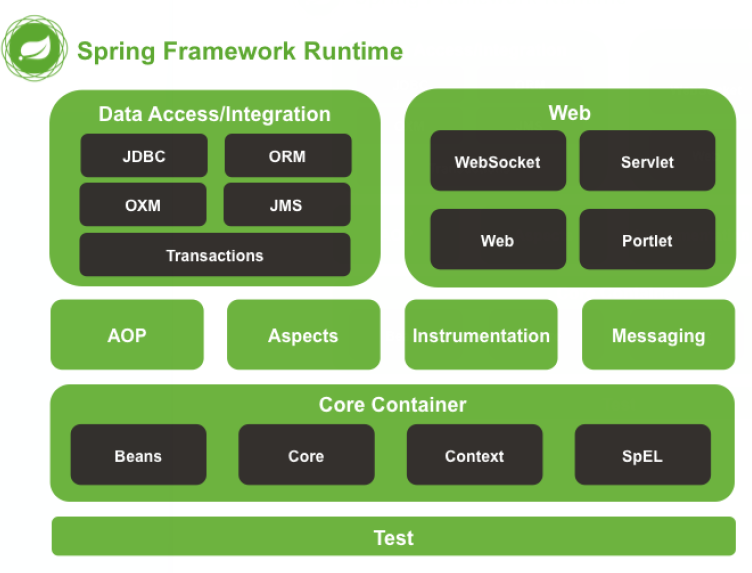iwehdio的博客园:https://www.cnblogs.com/iwehdio/
1、Spring入门
Spring是分层的Java SE/EE应用 full-stack轻量级开源框架,以IoC(Inverse Of Control:反转控制)和AOP(Aspect Oriented Programming:面向切面编程)为内核,提供了展现层Spring MVC和持久层Spring JDBC以及业务层事务管理等众多的企业级应用技术,还能整合开源世界众多著名的第三方框架和类库,逐渐成为使用最多的Java EE企业应用开源框架。
-
两大核心:IOC反转控制和AOP面向切片编程。
-
Spring的优势:方便解耦、简化开发、AOP编程的支持、声明式事务的支持、方便程序测试和集成框架、降低JavaEE API的使用难度。
-
Spring的体系结构:
- Core Container:核心容器,任何组件运行都需要核心容器,IOC相关。
- AOP层。
- 持久层。
- Web层。
- Test层。

-
程序的耦合:
-
传统的JDBC的使用:
public class JdbcDemo1 { public static void main(String[] args) throws SQLException { //1、注册驱动 DriverManager.registerDriver(new com.mysql.jdbc.Driver()); //2、获取连接 Connection conn = DriverManager.getConnection("jdbc:mysql:///localhost:3306/spring","root","root"); //3、获取预处理对象 PreparedStatement pstm = conn.prepareStatement("select * from account"); //4、执行SQL ResultSet rs = pstm.executeQuery(); //5、遍历结果 while (rs.next()) { System.out.println(rs.getString("name")); } //6、释放资源 rs.close(); conn.close(); pstm.close(); } }- 如果不导入 mysql ,则会出现编译期报错,缺少编译期依赖。
-
程序的耦合:程序间的依赖关系。
- 类之间的依赖。
- 方法之间的依赖。
-
解耦:降低程序间的依赖关系。
-
应该做到的是,编译期不依赖,运行时才依赖。
-
可以使用反射注册驱动:
Class.forname("com.mysql.jdbc.Driver");- 此时是一个运行时异常,而不是编译期错误。
-
解耦的思路:
- 使用反射创建对象,而避免使用
new关键字。 - 通过读取配置文件来获取要创建的对象的全类名。
- 使用反射创建对象,而避免使用
-
-
工厂类和工厂模型:
-
例如在三层架构中,服务层service 调用持久层dao,需要 new 一个 dao的实现类。表现层Servlet 调用服务层service 也需要 new 一个 service 实现类,使得程序耦合性很高。
-
Bean:在计算机中有可重用组件的含义。
-
JavaBean:不只是实体类,而是指用Java编写的可重用组件。
-
创建配置文件,用键值对的形式存储全类名。然后通过反射创建对象。
-
使用工厂模型解耦:
//BeanFactory.java public class BeanFactory { private static Properties props; static { try { props = new Properties(); InputStream in = BeanFactory.class.getClassLoader().getResourceAsStream("bean.properties"); props.load(in); } catch (IOException e) { e.printStackTrace(); } } public static Object getBean(String beanName) { Object bean = null; String beanPath = props.getProperty(beanName); try { bean = Class.forName(beanPath).newInstance(); } catch (InstantiationException e) { e.printStackTrace(); } catch (IllegalAccessException e) { e.printStackTrace(); } catch (ClassNotFoundException e) { e.printStackTrace(); } return bean; } } //Client.java public class Client { public static void main(String[] args) { AccountService accountService = (AccountService) BeanFactory.getBean("accountService"); accountService.saveAccount(); } } -
服务层的表现层:
//AccountServiceImpl.java public class AccountServiceImpl implements AccountService { private AccountDao accountDao = (AccountDao) BeanFactory.getBean("accountDao"); public void saveAccount() { accountDao.save(); } } //AccountDaoImpl.java public class AccountDaoImpl implements AccountDao { @Override public void save() { System.out.println("baocun"); } } -
这样每次反射都要重新创建对象,是多例的,但是单例的效果更高。可以使用一个容器,保存所有反射创建的对象。
public class BeanFactory { private static Properties props; private static Map<String, Object> beans; static { try { props = new Properties(); InputStream in = BeanFactory.class.getClassLoader().getResourceAsStream("bean.properties"); props.load(in); beans = new HashMap<String, Object>(); Enumeration keys = props.keys(); while (keys.hasMoreElements()) { String key = keys.nextElement().toString(); String beanPath = props.getProperty(key); Object value = Class.forName(beanPath).newInstance(); beans.put(key, value); } } catch (Exception e) { e.printStackTrace(); } } public static Object getBean(String beanName) { return beans.get(beanName); } }
-
2、IOC
控制反转,把创建对象的权利交给框架或工厂,削减了耦合关系。
-
创建配置文件 bean.xml 并导入约束:
<?xml version="1.0" encoding="UTF-8"?> <beans xmlns="http://www.springframework.org/schema/beans" xmlns:xsi="http://www.w3.org/2001/XMLSchema-instance" xsi:schemaLocation="http://www.springframework.org/schema/beans http://www.springframework.org/schema/beans/spring-beans.xsd"> </beans> -
把对象交给 Spring 管理:
<bean id="accountService" class="cn.iwehdio.service.Impl.AccountServiceImpl"></bean> <bean id="accountDao" class="cn.iwehdio.dao.Impl.AccountDaoImpl"></bean>id属性是键,class属性是所要创建的全类名。
-
使用spring创建对象:
public class Client { public static void main(String[] args) { //1、获取核心容器 ApplicationContext ac = new ClassPathXmlApplicationContext("bean.xml"); //2、根据Id获取bean对象 AccountService accountService = (AccountService) ac.getBean("accountService"); AccountDao accountDao = ac.getBean("accountDao", AccountDao.class); System.out.println(accountService); System.out.println(accountDao); } }- 两种获取方式,强转或传入字节码。
-
ApplicationContext的三个实现类:ClassPathXmlApplicationContext:可以加载类路径(resources)下的配置文件,要求文件必须在类路径下。FileSystemXmlApplicationContest:可以加载磁盘任意路径下的配置文件。AnnotationConfigApplicationContext:用于读取注解创建容器。
-
核心容器的两个接口:
ApplicationContext:在构建核心容器时,创建对象采取的策略是立即加载的方式。一读取完配置文件就马上创建配置文件中的对象。- 使用场景是单例对象。一般使用此对象。
BeanFactory:在构建核心容器时,创建对象采取的策略是延迟加载的方式。什么时候获取,什么时候才创建对象。- 使用场景是多例对象。
-
三种创建 bean 对象的方式:
-
使用默认构造函数创建。使用
<bean>标签,且除了 id 和 class 没有其他属性。如果没有默认构造则不能创建。<bean id="创建的类" class="创建的类的全类名"></bean> -
使用普通工厂中的方法创建对象(使用某个类中的方法创建对象)。
<bean id="工厂创建的类" factory-bean="工厂类全类名" factory-method="工厂中创建对象的方法"></bean> -
使用静态工厂中的静态方法创建对象(使用某个类中的静态方法创建对象)。
<bean id="静态创建的类" class="工厂类全类名" factory-method="静态方法"></bean>
-
-
bean 的作用范围:
- 默认情况下是单例的。也就是多次创建的是同一个对象。
<bean>标签的scope属性用于指定作用范围:- singleton:单例、默认值。
- prototype:多例。
- request:作用于 Web 应用的请求范围。
- session:作用于 Web 应用的会话范围。
- global-session:作用于集群环境的会话范围。
-
bean 的生命周期:
- 对于单例对象:生命周期与容器相同。
- 当容器创建时,对象出生。
- 容器存在时,对象一直存在。
- 容器销毁时,对象也销毁。
<bean>标签的init-method和destroy-method属性用于指定初始化前和销毁后的方法。- 对于多例对象:
- 对象将要被使用时,对象出生。
- 对象在使用过程中一直存在。
- 对象长时间没有被使用且没有别的对象引用时,由垃圾回收器回收。
- 对于单例对象:生命周期与容器相同。
3、Spring依赖注入
- 依赖关系的维护:在当前类所需要其他类的对象,由Spring提供,只需在配置文件中配置。
dependency Injection,依赖关系的维护称为依赖注入。
-
能注入的数据:
- 基本类型和String。
- 在配置文件或注解中配置的 bean 。
- 复杂类型 / 集合类型。
-
注入的方式:
- 构造函数提供。
- set 方法提供。
- 注解提供。
-
使用构造函数注入:
-
经常变化的数据不适合注入的方式。
-
使用
<bean>标签中的<constructor-arg>标签。 -
type 属性:用于指定所要注入的数据类型,是构造函数中某些参数的类型。
-
index 属性:用于指定要注入的数据给构造函数中指定索引位置的参数赋值(从0开始)。
-
name 属性:用于给构造函数中指定名称的参数赋值。
-
value 属性:用于提供基本类型和String类型的数据。
-
ref 属性:用于引入其他的 bean 类型数据,即在 Spring 的 IOC 核心容器中出现过的 bean 对象。
-
优势:获取 bean 对象时,注入数据是必须的操作,否则无法创建。
-
劣势:改变了 bean 对象的实例化方式,使得在创建对象时必须注入规定好的数据。
-
示例:
-
在 accountServiceImpl 中创建:
public class AccountServiceImpl implements AccountService { private AccountDao accountDao = new AccountDaoImpl(); private String name; private Integer age; private Date birthday; public AccountServiceImpl(String name, Integer age, Date birthday) { this.name = name; this.age = age; this.birthday = birthday; } public void saveAccount() { System.out.println(name+' ' + age+" "+birthday); } } -
在 bean.xml 中配置:
<bean id="accountService" class="cn.iwehdio.service.Impl.AccountServiceImpl"> <constructor-arg name="age" value="18"></constructor-arg> <constructor-arg name="name" value="test"></constructor-arg> <constructor-arg name="birthday" ref="now"></constructor-arg> </bean> <bean id="now" class="java.util.Date"></bean> -
测试:
public class Client { public static void main(String[] args) { //1、获取核心容器 ApplicationContext ac = new ClassPathXmlApplicationContext("bean.xml"); //2、根据Id获取bean对象 AccountService accountService = (AccountService) ac.getBean("accountService"); accountService.saveAccount(); } }
-
-
-
set 方法注入:
- 使用
<bean>标签中的<property>标签。 - name 属性:注入时调入的 set 方法名称(属性名)。
- value 属性:提供基本类型和String的数据。
- ref 属性:提供 bean 类型数据。
- 优势:创建对象时没有明确的现在,可以使用默认构造。
- 劣势:如果某个成员必须有值,无法保证注入。
- 使用
-
集合的注入:
- 使用
<property>标签中包含的标签。 - 数组使用
<array>标签下的<value>内注入。 - List使用
<list>标签下的<value>内注入。 - Set使用
<set>标签下的<value>内注入。 - Map使用
<map>标签下的<entry>标签的key和value属性。 - Rroperty使用
<map>标签下的<prop>标签的key和包含的value内容。 - 在List结构和Map结构集合中可互换。
- 使用